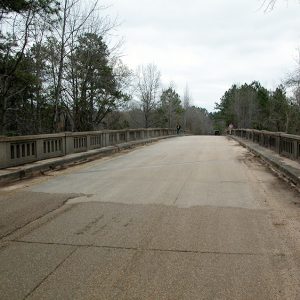calsfoundation@cals.org
Old U.S. 79 Kingsland Segment
Constructed in 1916, Old U.S. 79, Kingsland Segment, is a historic road located in Kingsland (Cleveland County). The segment measures almost 2,150 feet in length. Added to the National Register of Historic Places on September 28, 2005, it continues to serve as a local road.
Kingsland incorporated in 1884, shortly after the Cotton Belt Railroad was constructed in Dorsey County. The heavily timbered county was renamed Cleveland County in 1885 to honor President Grover Cleveland. The railroad and other transportation systems became vitally important to the development of the economy of the county, as they were ways to get timber and other crops to market. By 1890, Kingsland was a thriving small community with a post office, a furniture factory, a wagon factory, and a number of stores; its population was about 464.
The exact date of the construction of the road that would become U.S. 79 is unknown, but it likely was built in the late 1800s while Kingsland continued to grow. The road first appeared on a state road map in 1916. With support from the national government, the road was graveled and became known as B-7 in 1924, serving as a secondary federal road. The road received a state designation in 1926 when it became Arkansas Highway 3. Paved with asphalt in 1930, the road became part of the federal highway system in 1935 when it officially became part of U.S. Highway 79.
With this new designation, the state highway commission refocused attention on improving the road, including reducing the number of unsafe rail crossings in the state. The section in Kingsland included a crossing of the St. Louis Southwestern Railway (commonly called the Cotton Belt) southwest of the community. The crossing was deemed to be dangerous, as the road did not approach the rail line in a perpendicular fashion. Rather, the road curved toward to the railroad, which also included a sharp turn nearby, making it difficult for drivers and rail workers to see oncoming trains or cars. Most of the unsafe crossings were relocated, but some required new construction rather than simply moving the crossing.
The crossing at Kingsland required an overpass, and separate bids for the overpass and approach roadwork were received on July 14, 1938. S. M. Dixon of Warren (Bradley County) received the contract for the overpass with a winning bid of $63,157. D. B. Hill of Little Rock (Pulaski County) received the contract for the road work with a winning bid of $19,694.
Originally constructed as a concrete road, the surface was later covered by a thin layer of chip seal. The twenty-two-foot-wide road includes built-in curbs and drainage. Each segment is eleven feet wide and fifty feet wide.
The overpass is constructed of flat concrete deck girders on metal rock bearings. Guardrails on the side of the bridge are constructed of cast concrete. Large end posts include plaques with details of the construction of the bridge.
Increased traffic on U.S. 79 led to the construction of a new roadway to the northwest of the segment. This new road opened in 1953, reducing traffic on what became known as Old U.S. Highway 79.
For additional information:
“Old U.S. 79, Kingsland Segment.” National Register of Historic Places nomination form. On file at Arkansas Historic Preservation Office, Little Rock, Arkansas. Online at http://www.arkansaspreservation.com/National-Register-Listings/PDF/CV0055.nr.pdf (accessed July 16, 2020).
David Sesser
Henderson State University
 Early Twentieth Century, 1901 through 1940
Early Twentieth Century, 1901 through 1940 Historic Preservation
Historic Preservation Transportation
Transportation Kingsland Segment Overpass
Kingsland Segment Overpass 




Comments
No comments on this entry yet.